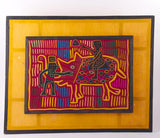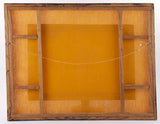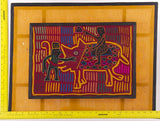Mola Textile Elephant Rider Hand Stitched Brilliant Colors Early 1900
Mola Textile, Elephant Rider, Hand Stitched By The Kuna Indian Women Of Central America, Brilliant Colours, Framed, Early 1900's.
What is Mola?
The answer is simple. Molas are colourful panels that include various types of appliqué and often have added embroidery. Once assembled, they are placed on both the lower front and lower back of a blouse. These blouses are only part of the daily attire worn by the Kuna Indian women of Central America. The mola blouses, and mola panels, in and of themselves, have come to be prized collectibles among textile enthusiasts and museums.
Abandonment of Traditional Dress Urged
The year 1907 marked the beginning of pressure by outsiders for the Kuna to abandon their visible signs of tradition, and to become more “civilized.” In 1913, the conflict escalated when Miss Anna Coope, a Protestant missionary, arrived on Narganá Island.
Her insistence that the women do not wear their usual attire was a quest taken up by other missionaries. Soon, government officials intervened and molas were confiscated by police forces kept on the islands. The Indians, who did not wish to be told how to dress, launched the bloody Tule Rebellion of 1925, during which all the whites present on their territory were either killed or expelled.
Since that time, the land of the Kuna has been a semi-autonomous territory of Panama. The Kuna are self-governing and their leaders convene daily in a congress (meeting) to make decisions. The Kuna call their homeland Kuna Yala which means Kuna homeland. To the rest of the world, the area where they live is called the San Blas Islands or the Comarca de San Blas. Some islands have as few as fifty inhabitants while others accommodate more than 1,000 people. Overcrowding is beginning to be problematic.
Highly Collectible Art
In their tropical island environment of origin, molas do not last very long. They are stored by hanging them around the interior perimeter of the hut and the salty sea air eventually destroys them. For that reason, there are no very old “antique” molas in existence, that are still located on the islands. Recently, molas have become highly collectible items for art connoisseurs the world over. Molas can be seen in some of the finest museums throughout the United States and Europe.
The Smithsonian collection includes the thirty mola blouses that were collected between 1904-1908 by Eleanor Yorke Bell, the first person known to have photographed molas. Another early collector, Lady Richmond Brown, bought 200 molas on the islands in 1922. Three-fourths of them are located in Great Britain’s Museum of Mankind. Museums in Germany, Sweden, and elsewhere in Europe have notable collections. One very noteworthy collection in New England is located at the University of Connecticut, Storrs.
Three hundred molas that were among the much more collected by Elisabeth Hans during her lifetime, were donated to the art department. We were lucky enough to have seen an outstanding exhibit which featured some of these works.
Item Code - TEX15C560PAN
Width: 24 3/4" Height: 19 1/2" Depth: 1 1/2" Weight: 1.289 kg











